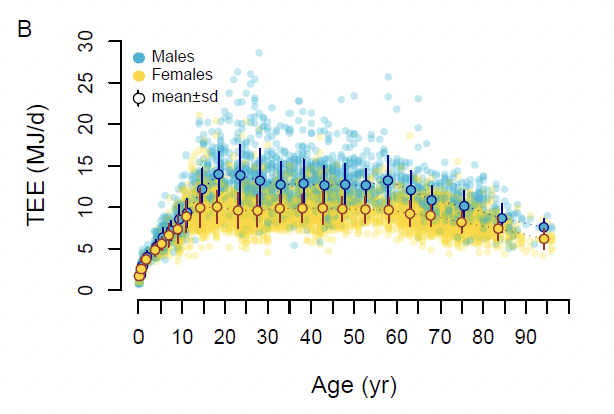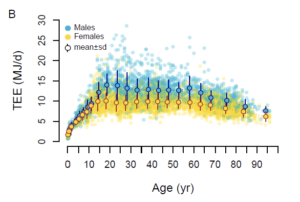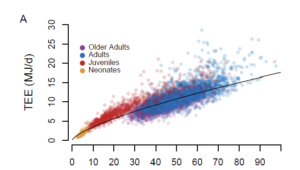Everything we have known about metabolism is wrong

My wife has been reminding me over the past few years that I need better coping strategies for stress aside from watching sports and overeating which tend to be my fallbacks. She has encouraged me to try meditation and other forms of focussed relaxation however nothing has really ‘stuck’.
A passion of mine is reading. Over the past year after we get the 3 kids to sleep but before catching up on work and emails that tend to consume too much of my evening, I tell my wife I am going to meditate and set off to read for about 30 minutes, typically with a half glass of red wine in hand.
Though my form of ‘meditation’ may not jive with what my wonderful wife had in mind, the result is the same. I feel less stress, my blood pressure has lessened, and I get the added benefit of feeling like I learned something as I exclusively read non-fiction (though I am trying to work on this).
Coinciding with my meditation practice, was me reaching 40. Like many, I have noticed I need to be more mindful of what I am eating, require increased consistency in exercise, and generally need to focus on healthier choices to try and maintain my health status. This is really just a nice way of saying I’ve reached the point where if I’m too lazy, my pants feel tight.
Like most folks I blamed it on my age, and in particular my ‘slowing metabolism’.
Then I read an article that completely blew this up. It is one of those generational research papers that will have to be incorporated in textbooks moving forward and one that completely changes everything we used to think we knew about metabolism.
If you did a quick survey of people in your circle, including your physician and other medical professionals, they would agree that after around age 20 our metabolism begins to slow down. This trend tends to be worse in women, and gets amplified by menopause. By mid-adulthood it is difficult to even stay close to your ideal weight. It is battle for the rest of your life. The villain in all of this? Why a slowing metabolism of course!
But what if I told you this is a complete falsehood. What if the only reason we have believed this is because it has really never been adequately studied and because it allows us an excuse for putting on excess weight? What if a brand new paper in one of the top 2 most prestigious scientific journals in the world has proven that what we always thought about metabolism is just plain wrong, and instead we go through 4 defined age related ‘phases of metabolism’ with little variation?
You see the major issue with metabolism studies has always been their cost. Most studies just predict your metabolism using something called your basal metabolic rate which is really just the calories you burn while resting. They infer a predictable amount of physical activity and sometimes your body composition and use an equation to get your total energy expenditure. The issue is that your basal metabolic rate typically accounts for somewhere between 50 and 70% of your total energy expenditure, so this is a very incomplete measure.
But the gold standard for how much you actually burn is a more expensive method called double labeled water. Essentially it measures your calorie output by measuring the amount of carbon dioxide you exhale throughout a day. Obviously observational studies using methods such as these are cost prohibitive and this is why we really know very little in terms of accurate information on metabolism.
But then a researcher from Duke named Herman Pontzer convinced a large group of researchers to essentially group and share their data. The reward is that each would become a co-author of arguably the most important metabolism paper of all time. And so we ended up with a record EIGHTY co-authors on this important paper. The paper combined data from the 6 major labs that study metabolism, extracting data from a 40 year period to answer some basic questions that we have never actually studied before.
The study was massive. It included 6,421 people, blowing any prior studies out of the water in terms of size. Importantly it was also geographically and economically diverse, representing 29 countries. They included infants all the way up to 95 year-olds. This was truly a representative sample of our entire species.
The major finding in the study was that both total energy expenditure (total metabolic rate) AND basal expenditure (resting metabolic rate) increase with fat free mass in a power law manner. No surprise there. Essentially, the more non-fat mass you have (obviously the major contributor to this is muscle, but this also includes organs and other tissues), the greater your overall daily expenditure will be. In fact, body size, particularly fat free mass, accounted for most (83%) of the variation in total daily expenditure.
The issue with researching metabolism is that if we know that people with more fat free mass burn more calories, it makes it hard to look at other factors like gender and age and how much they contribute to metabolism.
To solve this, the researchers were able to use statistics to essentially ‘mute’ the fat free mass part of the equation to then standardize individuals to allow them to look at other variables for the first time ever.
It turns out that we have 4 distinct phases of energy expenditure:
- Infancy (up to around age 1): When we are born, we surprisingly have the same energy expenditure as our mothers. Previously it was though that we come out of the womb burning a super high level of calories but this is not the case. At some point into the first year, something ‘kicks in’ and we start our engines. In fact, between 9 and 15 months, our total adjusted and basal expenditures are about 50% higher than adult level. Unfortunately, this is our peak burn during our lifetimes.
- Age 1-20: Our total calories continue to increase, however relative to our body size they actually slow by about 3% per year from the peak at age 1. One of many surprises in the study is that there was NO PUBERTAL INCRESASE in total energy expenditure and no difference in terms of gender. In fact when adjusted for body size, humans hit our adult burn at around age 20. This is where things get interesting.
- Age 20-60: We keep THE SAME METABOLIC OUTPUT. You read that correctly. There is no adjusted slowing of metabolism through adulthood. There was also no difference between genders. Adjusted and total expenditure even stayed stable during pregnancy!
- Age 60 and on: We decline by about 0.7% per year. The break point was actually around age 63. By the time you hit your 90’s your about 26% lower output then you were in middle age.
Here is a graphical interpretation of the human population’s total energy expenditure throughout their lifetime (age on the X axis and total energy expenditure is on the Y axis). Note how remarkably consistent it stays from age 20 through age 60.

Like many of you I was very disappointed to take all of this in. Gone are my assumptions on metabolism, and more importantly my excuses for requiring a larger belt size.
Adult expenditures when adjusted for body size and composition are remarkably stable, even during pregnancy and the post-partum period.
Some random thoughts I had on reading the article:
- On average, adults across the entire population gain roughly 1.5 pounds per year. We can no longer blame this on metabolism.
- The authors note the first year is now confirmed as critical in terms of nutrition as shown in nutritionally stressed populations where growth often falters following the first year.
- In each age range there was some variability. The total PATTERN for each age range held true, however within an age cohort there would be people that burn 25% above the average, and some that burn 25% below average. What are the characteristics of these folks? Is there a genetic link? Could this help us better understand obesity and other body types?
- The New York Times wrote a piece on this article and noted that the decline after age 60 has implications. You see, energy requirements of just the heart, liver, kidney and brain account for about 65% of your resting metabolic rate despite just contributing 5% of your total body weight. The slowing of your metabolism at age 60 is likely then linked to your organs not functioning as well as they should. The authors go so far as to note that despite how ‘young’ a person looks in their 60’s, biologically their organs are likely not functioning nearly as well as they had previously. You cannot outrun human biology at this point.
- This suggests there could be better targeted interventions based on age, a persons size and the amount of fat free mass a person has.
Or maybe the key is trying to retain as much fat free mass as you possibly can? Remember that all of these findings were after controlling for the amount of fat free mass people have, essentially taking that variable out and then comparing. Below is a graph from the article showing the relationship between fat free mass (X axis) and total energy expenditure (Y axis). Essentially, the more fat free mass you have, regardless of age, the more energy you expend.

I guess I should consider ditching my 30 minutes of ‘meditation’ with wine and maybe go for a walk and listen to an audiobook.
